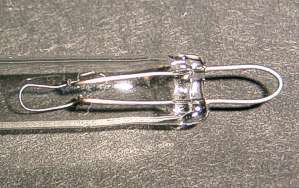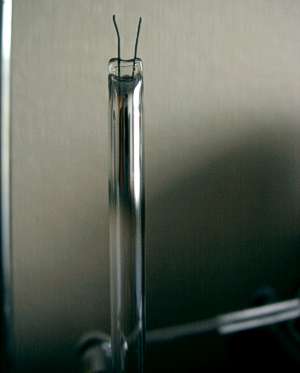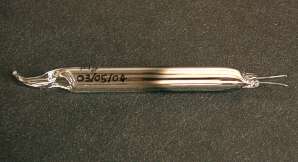
Glass Blowing for Vacuum Devices
Evaporation of Magnesium
Very early vacuum tubes often had a short life because gases were released from the
component parts of the tube in operation, causing the internal pressure to rise to
an unworkable level. It was found that evaporating a small quantity of magnesium
inside the tube at the time of sealing off from the pump helped to keep the pressure
down. The evaporated material, termed a getter, acts as an auxiliary pump. In practice
magnesium is no longer used in this way because it is ineffective at gettering anything
other than oxygen. Alkaline-earth metals such as barium are superior. Barium will
getter carbon monoxide, carbon dioxide, hydrogen, nitrogen and oxygen. A good getter
can reduce the pressure in a sealed off device below the original pumping pressure by
several decades. The device must be very clean for this to occur.
This was an experiment to see what problems might be encountered when evaporating a
metal inside a device which is to be sealed off. The tube described below serves no
function other than as a test piece.
 I started with a 8mm diameter tube and a short length of 0.5mm diameter nickel / iron
(Ni/Fe) wire. I cut a thin strip of magnesium (Mg) from a reel of magnesium ribbon and
crimped the ends of the Ni/Fe wire to it. It was quite difficult because the Mg is so
much softer than the Ni/Fe.
I started with a 8mm diameter tube and a short length of 0.5mm diameter nickel / iron
(Ni/Fe) wire. I cut a thin strip of magnesium (Mg) from a reel of magnesium ribbon and
crimped the ends of the Ni/Fe wire to it. It was quite difficult because the Mg is so
much softer than the Ni/Fe.
The Ni/Fe wire was then sealed in to the end of the tube in the usual way. In the picture,
the Mg loop is on the left. The wire loop on the right is to be cut. Current can then be
applied to ohmically heat the Mg until it evaporates.
 The tube was mounted on the pump and the pressure taken down to 6x10-5mbar. To
evaporate the Mg, a Superspeed soldering iron transformer was powered from a Variac (variable
auto-transformer). The Superspeed transformer is rated at 3.5V, 150VA.
The tube was mounted on the pump and the pressure taken down to 6x10-5mbar. To
evaporate the Mg, a Superspeed soldering iron transformer was powered from a Variac (variable
auto-transformer). The Superspeed transformer is rated at 3.5V, 150VA.
No current would flow, even with the variac turned up full. I deduced that there must be
a layer of magnesium oxide insulating the Mg from the connecting wires. To break down
the oxide layer, I temporarily connected the tube to a current limited 0 to 35V dc
power supply. I gradually increased the voltage and found that the oxide broke down at 27V.
The 2A limit light on the power supply then remained on down to a few volts.
I then reconnected the tube to the Superspeed transformer. The current was not very stable
and kept drifting down, indicating that the resistance was increasing.
 I was suddenly distracted by the vacuum pressure gauge tripping out. By the time I had
looked back at the tube, the Mg had evaporated and gone open-circuit again. The rig
pressure did not fall noticeably.
I was suddenly distracted by the vacuum pressure gauge tripping out. By the time I had
looked back at the tube, the Mg had evaporated and gone open-circuit again. The rig
pressure did not fall noticeably.
The sealed-off tube can be seen in the picture on the left. The Mg has evaporated on to the
glass at the right hand end of the tube producing a bright mirror finish.
 I started with a 8mm diameter tube and a short length of 0.5mm diameter nickel / iron
(Ni/Fe) wire. I cut a thin strip of magnesium (Mg) from a reel of magnesium ribbon and
crimped the ends of the Ni/Fe wire to it. It was quite difficult because the Mg is so
much softer than the Ni/Fe.
I started with a 8mm diameter tube and a short length of 0.5mm diameter nickel / iron
(Ni/Fe) wire. I cut a thin strip of magnesium (Mg) from a reel of magnesium ribbon and
crimped the ends of the Ni/Fe wire to it. It was quite difficult because the Mg is so
much softer than the Ni/Fe.
 The tube was mounted on the pump and the pressure taken down to 6x10-5mbar. To
evaporate the Mg, a Superspeed soldering iron transformer was powered from a Variac (variable
auto-transformer). The Superspeed transformer is rated at 3.5V, 150VA.
The tube was mounted on the pump and the pressure taken down to 6x10-5mbar. To
evaporate the Mg, a Superspeed soldering iron transformer was powered from a Variac (variable
auto-transformer). The Superspeed transformer is rated at 3.5V, 150VA. I was suddenly distracted by the vacuum pressure gauge tripping out. By the time I had
looked back at the tube, the Mg had evaporated and gone open-circuit again. The rig
pressure did not fall noticeably.
I was suddenly distracted by the vacuum pressure gauge tripping out. By the time I had
looked back at the tube, the Mg had evaporated and gone open-circuit again. The rig
pressure did not fall noticeably.